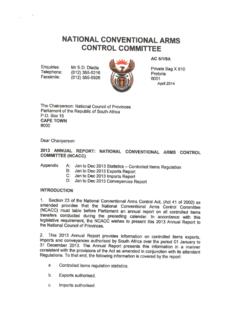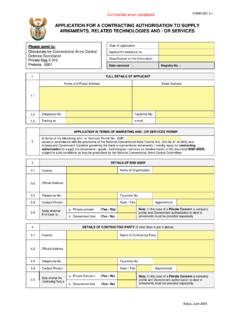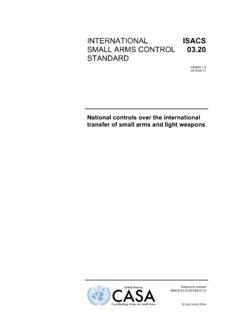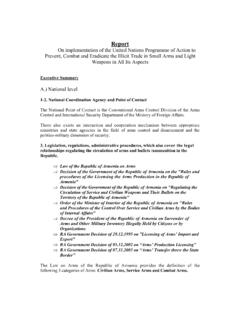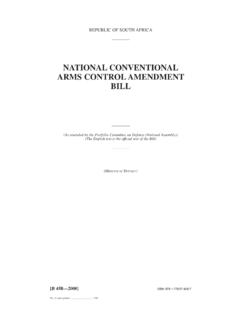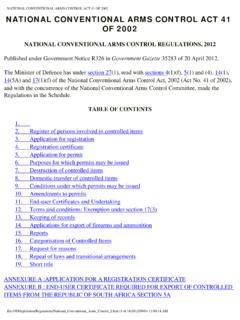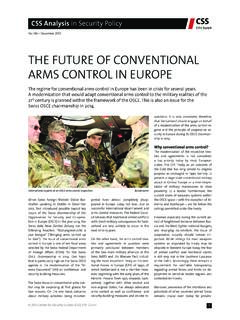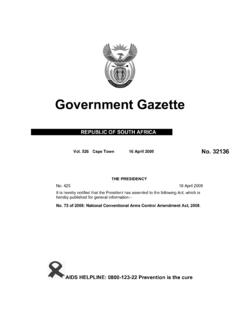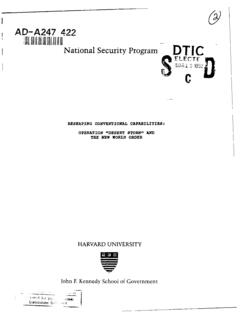Transcription of Arms Trade Treaty
1 ArmsTradeTreatyBaseline Assessment ProjectThe ATT Baseline Assessment ProjectGuidance for Completing the Initial Report on Implementation MeasuresArmsTradeTreatyBaseline Assessment ProjectATT-BAP REPORTING GUIDANCE NOTESMODULE 1 national control LISTNATIONAL control LISTS: RELEVANT ATT ARTICLESA rticle 21. This Treaty shall apply to all conventional arms within the following categories: (a) Battle tanks; (b) Armoured combat vehicles; (c) Large-calibre artillery systems; (d) Combat aircraft; (e) Attack helicopters; (f) Warships; (g) Missiles and missile launchers; and (h) Small arms and light weapons2. For the purposes of this Treaty , the activities of the international Trade comprise export, import, transit, trans-shipment and brokering, hereafter referred to as transfer .3. This Treaty shall not apply to the international movement of conventional arms by, or on behalf of, a State Party for its use provided that the conventional arms remain under the State Party s 3 Each State Party shall establish and maintain a national control system to regulate the export of ammunition/munitions fired, launched or delivered by the conventional arms covered under Article 2 (1), and shall apply the provisions of Article 6 and Article 7 prior to authorizing the export of such 4 Each State Party shall establish and maintain a national control system to regulate the export of parts and components where the export is in a form that provides the capability to assemble the conventional arms covered under Article 2 (1)
2 And shall apply the provisions of Article 6 and Article 7 prior to authorizing the export of such parts and arms Trade Treaty -Baseline Assessment project has developed a series of nine ATT-BAP Guidance Notes to assist States in the completion of their national ATT-BAP Survey and in the preparation of their initial report on measures to implement the arms Trade Treaty , as required under Article 13 (1). Each of the ATT-BAP Guidance Notes focuses upon a particular topic and ATT commitment. Each Note: Identifies the relevant Treaty articles for each topic Introduces the ATT-BAP Survey questions and a sample of responses provided by States Provides information on potential sources of information for addressing the ATT-BAP Survey questions, highlighting similar questions or relevant responses contained in national reports on transfer control systems for other international instrumentsATT-BAP ATT-BAP Survey contains several questions for States to explain how they fulfill their ATT commitments with regard to the establishment and maintenance of a national control list that covers, at a minimum, the eight categories of conventional arms outlined in Article 2(1) of the ATT, as well as ammunition and components that are used for assembling conventional arms as defined in Articles 3 and 4.
3 Examples of answers provided by States that completed ATT-BAP Surveys during 2013-2015 are included below to show the types of information that States have included in their Surveys and are indicative of the type of information governments are willing to share publicly on measures taken to implement the ATT. Completed Surveys are available for review via the Country Profiles and Database pages on the arms Trade Treaty Baseline Assessment Project Portal at: < >YesNoResponse taken from ATT-BAP Survey completed by ArgentinaB. For which activities does your State maintain a national control list of conventional arms : [Article and Article ]i) Exportii) Importiii) Transit / Transshipmentiv) Brokering1. national control LISTATT-BAP SURVEY QUESTIONSM odule 1 Article State Party shall establish and maintain a national control system, including a national control list, in order to implement the provisions of this TreatyArticle State Party is encouraged to apply the provisions of this Treaty to the broadest range of conventional arms .
4 national definitions of any of the categories covered under Article 2 (1) (a)-(g) shall not cover less than the descriptions used in the United Nations Register of conventional arms at the time of entry into force of this Treaty . For the category covered under Article 2 (1) (h), national definitions shall not cover less than the descriptions used in relevant United Nations instruments at the time of entry into force of this TreatyATT-BAP taken from ATT-BAP Survey completed by FranceC. Does your national control list cover the following: [Articles , 3, 4, and ]i) Battle tanks [Article ]ii) Armored combat vehicles [Article ]iii) Large-caliber artillery systems [Article ]iv) Combat aircraft [Article ]v) Attack helicopters [Article ]vi) Warships [Article ]vii) Missiles and missile launchers [Article ]viii) Small arms and light weapons [Article ]ix) Ammunition / Munitions for the above items [Article 3]x) Parts and components requiring control for the above items [Article 4]YesNoResponse taken from ATT-BAP Survey completed by SloveniaD.
5 Is/are your national control list(s) publicly available? [Article ]i) If yes, please provide a copy or link to where your control list is made publicly available. taken from ATT-BAP Survey completed by ItalyE. Are the controlled items defined? [Article ]i) If yes, which definition(s) do you use? ( Wassenaar, United Nations Register of conventional arms , national definitions, etc.)The definitions are derived from the relevant multilateral and European rules (EU Common Position 2008/944/CFSP, the Wassenaar Arrangement, the United Nations Register of conventional arms ).Module 1 ATT-BAP information required to answer the questions and sub-questions contained in Section 1 national control List will be contained in primary and/or secondary legislation or a Presidential decree, as well as policy guidelines. States may be able to find and use relevant information contained within their reports on implementation of the UN Programme of Action (PoA) or UN Security Council Resolution 1540 specifically with regard to questions on legislation, policy guidelines and FOR INFORMATIONRELEVANT QUESTION(S) FROM UNSCR 1540 IMPLEMENTATION REPORT MATRIX:ATT-BAP SURVEY QUESTION(S)UN POA REPORTING TEMPLATE QUESTION(S)UNSCR 1540 IMPLEMENTATION REPORT MATRIX QUESTION(S)Question Does your national control list cover the following.
6 I)Battle tanks ii)Armored Combat Vehicles iii)Large-caliber artillery systems iv)Combat aircraft v)Attack helicopters vi)Warships vii)Missiles and missile launchers viii)Small arms and light weapons ix)Ammunition / Munitions for the above items x)Parts and components requiring control for the above itemsOP 6, 7, and 8(d). control lists, Assistance, Information Can information be provided on the following issues?: (1) control Lists items (goods / equipment / materials / technology); (2) control Lists - otherQuestion Is/are your national control list(s) publicly available?Can information be provided on the following issues?: (1) control Lists items (goods / equipment / materials / technology); (2) control Lists - otherQuestion Are the controlled items defined? Can information be provided on the following issues?
7 : (1) control Lists items (goods / equipment / materials / technology); (2) control Lists - otherArmsTradeTreatyBaseline Assessment ProjectATT-BAP REPORTING GUIDANCE NOTESMODULE 2 EXPORTSEXPORTS: RELEVANT ATT ARTICLESA rticle State Party shall take measures necessary to implement the provisions of this Treaty and shall designate competent national authorities in order to have an effective and transparent national control system regulating the transfer of conventional arms covered under Article 2 (1) and of items covered under Article 3 and Article 4. Article exporting State Party shall take measures to ensure that all authorizations for the export of conventional arms covered under Article 2 (1) or of items covered under Article 3 or Article 4 are detailed and issued prior to the exporting State Party shall make available appropriate information about the authorization in question, upon request, to the importing State Party and to the transit or trans-shipment States Parties, subject to its national laws, practices or , after an authorization has been granted, an exporting State Party becomes aware of new relevant information, it is encouraged to reassess the authorization after consultations, if appropriate, with the importing State Party shall maintain national records, pursuant to its national laws and regulations, of its issuance of export authorizations or its actual exports of the conventional arms covered under Article 2 (1).
8 The arms Trade Treaty -Baseline Assessment project has developed a series of nine ATT-BAP Guidance Notes to assist States in the completion of their national ATT-BAP Survey and in the preparation of their initial report on measures to implement the arms Trade Treaty , as required under Article 13 (1). Each of the ATT-BAP Guidance Notes focuses upon a particular topic and ATT commitment. Each Note: Identifies the relevant Treaty articles for each topic Introduces the ATT-BAP Survey questions and a sample of responses provided by States Provides information on potential sources of information for addressing the ATT-BAP Survey questions, highlighting similar questions or relevant responses contained in national reports on transfer control systems for other international instrumentsModule 1 ATT-BAP ATT-BAP Survey contains several questions for States to explain how they fulfill their ATT commitments with regards to the establishment and maintenance of an export control system.
9 The questions seek information on export control legislation, relevant agencies, the authorization process and record-keeping for authorizations and actual exports, and relate to Articles 5, 7 and 12. Examples of answers provided by States that completed ATT-BAP Surveys during 2013-2015 are included below to show the types of information that States have included in their Surveys and are indicative of the type of information governments are willing to share publicly on measures taken to implement the ATT. Completed Surveys are available for review via the Country Profiles and Database pages on the arms Trade Treaty Baseline Assessment Project Portal at: < >YesNoDetails / Reference / Web link /Additional commentsResponse taken from ATT-BAP Survey completed by South AfricaA) Is the control of arms exports established in national legislation?
10 [Article ]The national conventional arms control (NCAC), Act 2002 (Act No 4 of 2002) as amended by the The national arms control Amendment Act 2008 (Act No 73 of 2008). The national conventional arms control Regulation, Notice No R 637 of 28 May 2004. The Firearms control Act, No 60 of 2000 as amended and its supporting notices and EXPORTS ATT-BAP SURVEY QUESTIONSA rticle State Party is encouraged to include in those records: the quantity, value, model/type, authorized international transfers of conventional arms covered under Article 2 (1), conventional arms actually transferred, details of exporting State(s), importing State(s), transit and trans-shipment State(s), and end users, as shall be kept for a minimum of ten / Reference / Web link /Additional commentsResponse taken from ATT-BAP Survey completed by MontenegroB) Which Ministry/ies or government agency/ies is/are responsible for implementing controls on arms exports?
